 If you are looking for an activity holiday or simply the most enjoyable and most efficient way to get and keep fit and healthy, there cannot be too many forms of exercise that fit the bill better than Pilates and Fencing - and especially when the instructors are as good -- and as charming as Robyn and Patrick!
If you are looking for an activity holiday or simply the most enjoyable and most efficient way to get and keep fit and healthy, there cannot be too many forms of exercise that fit the bill better than Pilates and Fencing - and especially when the instructors are as good -- and as charming as Robyn and Patrick!So, what exactly IS this Pilates phenomenon?
It is an Exercise in Balance : "I must be right. Never an aspirin. Never injured a day in my life. The whole country, the whole world, should be doing my exercises. They'd be happier.", said Jo Pilates in 1965, at the age of 86.
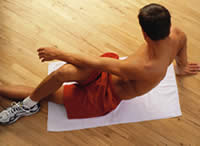
Well, maybe not the whole world, but certainly much of it is experiencing the explosion in demand for Pilates, a method of exercise and physical movement designed to stretch, strengthen, and balance the body. With systematic practice of specific exercises coupled with focused breathing patterns, Pilates has proven itself invaluable not only as a fitness endeavour itself, but also as an important adjunct to professional sports training and physical rehabilitation of all kinds.
Widely embraced among dancers for years, the exercises--"elephant," "swan", the language--"pull navel to spine, find the core connection! and breeaaaathe," and the look--bright-eyed, refreshed, buoyant-without-necessarily-sweating, is popping up in fitness classes, physical therapy offices, corporate retreats, luxury spas and wellness centers across the country. Another fad? A cult for the over-privileged? Think again. With the aging of our world population and the increasing trend toward mindful, moderate health practices, Pilates is more likely to find itself with a wait list at the YMCA, and in your local public schools--shaping the fitness ideals of our next generation.
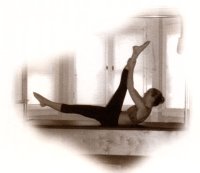 Practiced faithfully, Pilates yields numerous benefits. Increased lung capacity and circulation through deep, healthy breathing is a primary focus. Strength and flexibility, particularly of the abdomen and back muscles, coordination-both muscular and mental, are key components in an effective Pilates program. Posture, balance, and core strength are all heartily increased. Bone density and joint health improve, and many experience positive body awareness for the first time. Pilates teaches balance and control of the body, and that capacity spills over into other areas of one's life.
Practiced faithfully, Pilates yields numerous benefits. Increased lung capacity and circulation through deep, healthy breathing is a primary focus. Strength and flexibility, particularly of the abdomen and back muscles, coordination-both muscular and mental, are key components in an effective Pilates program. Posture, balance, and core strength are all heartily increased. Bone density and joint health improve, and many experience positive body awareness for the first time. Pilates teaches balance and control of the body, and that capacity spills over into other areas of one's life.If you are like myself - someone who hates aerobics with a passion, finds doing the circuit in gym beneficial and satisfying -- but utterly boring, but rrealises that a good form of exervice is absolutely crucial to keeping fit, supple and healthy, then look no further: the day you discover Pilates, a new world will open up for you!

And now Pilates has come to the Dordogne as well! Robyn Haigh, from Lalinde, has recently started Pilates classes in Lalinde as well as in Eymet. She works both with groups and in one-on-one classes.
And Fencing? Did that activity not go out with the Three Musketeers?

No! Not at all! Fencing, or l'Escrime, became very popular again in France during the last few years -- especially after the 2004 Olympic Games when the French won the most gold medals for fencing.
Fencing is a is a fantastic way to improve balance, co-ordination and flexibility - and it's great fun as well!
There are three types of fencing - epee, foils and sabre.
In all three, weapons are wired electronically to record when a hit is scored.
In foils and epee, points can only be scored by the point of the weapon hitting. In the case of the foil, only a hit on the torso counts. In the epee, the whole body is the target. In sabre, points can also be scored by hitting the arms and head.
As well as the three different types of sword, fencers also need protective clothing, including a wire mesh face guard.
A metallic over jacket is also worn. This is placed over the scoring area and conducts electricity. Every time a valid hit is scored a lamp lights up on the scoring equipment.
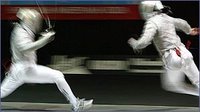 Fencing originated as the practice of swordsmanship to prepare men for duels and warfare. A fencing match is depicted on an Egyptian temple that dates to about 1190 B.C. and the ancient Babylonians, Greeks, Persians, and Romans all had some form of fencing. The use of armour during the Middle Ages made swordsmanship virtually obsolete. The broadsword was used against armour, but only as a crude hacking device requiring sheer strength rather than skill. By making armour obsolete, the development of firearms ironically brought swordplay back into prominence during the 15th century. Soldiers once again had to acquire some skill with the sword, and fencing also emerged as a pastime for gentlemen. Fencing masters organized guilds, which taught various moves to initiates while protecting them as trade secrets from outsiders.
Fencing originated as the practice of swordsmanship to prepare men for duels and warfare. A fencing match is depicted on an Egyptian temple that dates to about 1190 B.C. and the ancient Babylonians, Greeks, Persians, and Romans all had some form of fencing. The use of armour during the Middle Ages made swordsmanship virtually obsolete. The broadsword was used against armour, but only as a crude hacking device requiring sheer strength rather than skill. By making armour obsolete, the development of firearms ironically brought swordplay back into prominence during the 15th century. Soldiers once again had to acquire some skill with the sword, and fencing also emerged as a pastime for gentlemen. Fencing masters organized guilds, which taught various moves to initiates while protecting them as trade secrets from outsiders.


Fencing as an exercise based on speed and skill began when the longer, lighter rapier was developed in Italy during the 16th century. Because of the rapier's length, opponents had to fight at a distance and quick but controlled lunges, attacking the enemy with the point of the sword, replaced cruder hacking techniques. But the rapier wasn't a good defensive weapon, so the fencer often had to use his gauntleted left hand to parry his opponent's thrusts.
Under Louis XIV in France, a change in fashion led to a new kind of sword. The rapier simply didn't go well with brocaded jackets, breeches, and silk stockings, so French courtiers began wearing a shorter sword. The court sword, as it was known, turned out to be an excellent weapon for fencing because it was both lighter and stronger than the rapier, so it could be used for defense as well as offense. As a result, the modern one-handed fencing technique developed, with the left hand and arm used primarily for balance.
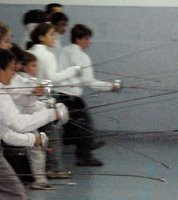
A special version of the court sword, the foil, was developed for practice. Meanwhile, another type of sword, the colichemarde, had been created for duelling. The blade had a triangular cross-section, with slightly concave sides to reduce weight without reducing strength. The colichemarde evolved into the modern epee.
The third of the fencing weapons, the saber, was introduced into Europe in the late 18th century as an adaptation of the Turkish scimitar, used by the Hungarian cavalry. It was so effective that other armies began using it and another variation, the cutlass, became a standard naval weapon.
The saber was originally a very heavy, curved sword, but a lighter, more easily wielded weapon with only a slight bend was developed in Italy late in the 19th century for duelling and fencing. The modern fencing weapon is straight, like the foil and epee, but it still has one cutting edge which can be used to make hits on an opponent.
 Fencing is one of only four sports that have been on every modern Olympic program since 1896. The Fédération Internationale d'Escrime, founded in 1913 to standardize rules, is the governing body for international fencing, including the Olympics.
Fencing is one of only four sports that have been on every modern Olympic program since 1896. The Fédération Internationale d'Escrime, founded in 1913 to standardize rules, is the governing body for international fencing, including the Olympics.There are fencing studios for anyone, from beginner to professional, in various centres in the Perigord -- the Cadets de Bergerac in Bergerac, of course!, with a studio in Eymet as well. To find out more and to find a class close to you, contact Patrick Wynn-Simmonds.
Patrick is a sabreur(sabre fencer), and recently received a bronze medal for the team Epée event at the Championnats de France at Alès in the Cevennes.
This past Sunday (28 May 2006) he also became Champion d'Aquitaine (Vétéran V1 Individuelle) at Mont de Marsan at the Championnats de Ligue Vétéran, again at Epée --- and after beating the Maitre d'armes of Périgueux in the quarter finals, and his club president in the semi!
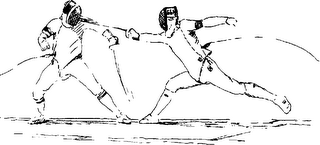
Click on Link:
Chateau Lalinde : The perfect venue for your event
TAGS: Events Rent a chateau France
Chateau
Perigord Food Holidays in France Recipes








6 comments:
I heartily agree that for getting very fit (and having one gigantic arm) - try fencing - also, since the 50's women no longer have to wear the long skirts while fencing (yeah, like that would happen). Of the three, I think Epee probably gives the highest level of cardio fitness, balance and stretching as doing repeated long lunges, jump-backs and running fleches in a matter of seconds is not uncommon.
Hi there! I just happened to stumble across your blog after doing a "Kate Mosse" search. I am sorry, but I find I cannot help but pointing out some factual errors. You said:
"The use of armour during the Middle Ages made swordsmanship virtually obsolete. The broadsword was used against armour, but only as a crude hacking device requiring sheer strength rather than skill."
This is simply not true, I'm afraid. First of all, the broadsword is a misnomer, as it simply refers to any sword with a blade broader than that of civilian smallswords. Second, the more armour, the craftier the swordsmanship. Swords were not designed to hack through heavy armour, and so one had to find a way to exploit weaknesses in armour. This is why swords, from the 13th century on, became narrower and stiffer, and LESS suited for cutting, but MORE suited for thrusts -- this enabled a better grip around the blade, in what is called half-swording. Especially if you are wearing full plate harness, the edge of a sword will hold no threat to you. The object would be to drive the point inbetween the gaps of the armour, as there is absolutely no way for a sword to penetrate that sort of armour. Swords were light -- anywhere between 2-3.5 lbs is reasonable, but if balanced properly they're going to feel much lighter. The heaviest swords, the greatswords, standing as tall as a man, would weigh at MOST 8-10 lbs -- heavier than that, and they are probably ceremonial swords.
As for the swordsmanship itself, I have a background in Japanese swordsmanship, but was surprised when I saw in old European manuals (such as Talhoffer, Ringeck a.o.), and practiced with European groups, that the similarities between longsword and katana techniques far outweigh the differences. I have since invested in authentic replicas of European swords. Among them a type XIIa (Oakeshott typology) longsword which appealed to me because of its heavy weight -- at 3lbs 11oz.
Of course, ARMA can explain it much better than I:
http://www.thearma.org/essays/weights.htm
Here are some Zornhau techniques:
http://www.youtube.com/watch?v=Y3DhjFUOG6Y
This is a demonstration of techniques, of course, and not sparring.
I apologize if I have sounded like an arrogant know-it-all, but this is one of my pet peeves. All fighting arts are, and were, by nature pragmatic. Weapons were therefore practical, too.
Best,
K.A.
Dear K.A.
Thank you so much for all that info --
LOL! As a literary researcher I realise only too well the pitfalls I create for myself when posting any information on my blog that is not first-hand knowledge! I think if I had to go into each of the items I touch on, the blog would have to take on a completely different character and almost become another Wikipedia -- rather than just touching on the multitude of fascinating subjects that encounter in my daily life in one of the most amazing corners of the world!
When I wrote that little piece about fencing as a sport, and started mentioning the different swords used in the sport, I was very tempted to start chatting about katanas (I am a zealous "Japanophile"!)and the Chinese dao - with its blood groove which broke the suction and made it easier to withdraw the sword from the victim's body -- all bloody interesting stuff! -- but as almost every time I post something, I have to hold myself back and remember what my blog is about!
When referring to the "broadsword", I pretty much took the same literary liberties as people have been doing over the centuries in speaking about the broadsword -- and also pretty much using my own knowledge of those pieces of heavy weaponry I have seen in medieval castles -- when one has to wonder how the people of those times, who were, according to evidence, much much smaller than we are today, were even able to lift the things let alone swing them to effect.
Looking at your one referred site, I came across this bit (cited below) -- which I hope will be adequate testimony in my defence! -- and go a little way to appease your pragmatic self!
Again thank you for the valuable contribution to my blog -- and I trust you will continue to read it and perhaps one day visit this beautiful part of the world!
Broadsword or Broad Sword?
Settling the Question of What’s in a Name??
http://www.thearma.org/essays/broadsword.htm
Dear red shoes,
Thank you for replying, and replying so quickly. Yes, that is certainly adequate for my "pragmatic self" :)
I am afraid I have only been to France on two occasions -- once on a family holiday to Bretagne, and once a two week vacation/wedding celebration near Chateau de Brie (where the celebration itself took place), SW of Limoges. Unfortunately the wedding did not last (no, it was not my wedding), but it was still among the most memorable trips I've made. What I have seen of France on both occasions was truly breathtaking. I have always loved history, especially the medieval kind, and have a special fondness for castles and cathedrals -- of which there is no shortage in France. And which is partly the reason I like your blog. :) We simply don't have the same richness of medieval history up here in the cold North. I would have gone to France more often if only I had the time and spoke the language... :(
Each year there is a Western Martial Arts seminar in Dijon, and I've been telling myself to go every time. But alas, I procrastinate.
As for my style of swordsmanship, I have been practicing Muso-Shinden Ryu Iaido for six years now, and have also practiced a little bit of sabre and Italian longsword with friends in London.
And now I feel guilty, because I am going to correct you again. The notorious "blood groove" actually has nothing to do with blood -- its proper name is "fuller", or "hi" on a Japanese blade. Its purpose is to reduce weight with the minimum loss of structural integrity (giving it the crossection of an I-beam), and sometimes to properly balance the blade. This is why you occasionally see katana with different fullers on either side, or perhaps just close to the habaki (collar). Sometimes they are purely decorative. They DO give the sword a much more distinctive "whoosh", though. Here is an example of creative fullering:
http://www.ksky.ne.jp/~sumie99/Uda.html
That sword also has an unusual, assymetrical crossection. As you may have guessed by now, I have a strong fascination with swords. :)
Best,
K.A.
LOL K.A! This is becoming a perfect case model for the difficulties one encounters in literary research!
But thank you again for the information -- and now MAKE the time to go to Dijon for the next seminar -- and then be sure to make a little detour via Lalinde and the Dordogne Valley -- the Valley of a Thousand castles! ------ and some of the best French fencers!
Hey! Girls! How are you?!
Well I am here just to share with you this cool site from Brazil, that I just, found out about it!
www.brazilianpassionwear.com
check it out:)
Post a Comment